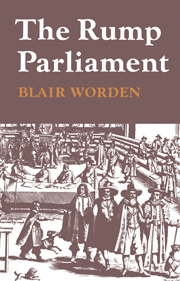Book contents
- Frontmatter
- Contents
- Dedication
- Acknowledgements
- Author's Note
- List of abbreviations
- Introduction
- PART ONE THE RUMP AND THE RUMPERS
- 1 Membership, attendance and allegiance
- 2 The limits of revolution
- 3 Moderation and conformity
- 4 Soldiers and clergymen
- 5 Commitment and corruption
- PART TWO THE RUMP AND REFORM
- PART THREE THE STRUGGLE FOR SURVIVAL, FEBRUARY 1649–SEPTEMBER 1651
- PART FOUR PARLIAMENT versus THE ARMY, SEPTEMBER 1651–APRIL 1653
- PART FIVE THE DISSOLUTION OF THE RUMP
- APPENDICES
- Bibliographical Guide
- Index
2 - The limits of revolution
Published online by Cambridge University Press: 29 January 2010
- Frontmatter
- Contents
- Dedication
- Acknowledgements
- Author's Note
- List of abbreviations
- Introduction
- PART ONE THE RUMP AND THE RUMPERS
- 1 Membership, attendance and allegiance
- 2 The limits of revolution
- 3 Moderation and conformity
- 4 Soldiers and clergymen
- 5 Commitment and corruption
- PART TWO THE RUMP AND REFORM
- PART THREE THE STRUGGLE FOR SURVIVAL, FEBRUARY 1649–SEPTEMBER 1651
- PART FOUR PARLIAMENT versus THE ARMY, SEPTEMBER 1651–APRIL 1653
- PART FIVE THE DISSOLUTION OF THE RUMP
- APPENDICES
- Bibliographical Guide
- Index
Summary
The Rump's enemies, mocking its occasional difficulty in its early stages in raising a quorum (a problem to which the Long Parliament was in fact well accustomed), have bequeathed the impression that only a hard core of extreme radicals sat in the House between the purge and the execution of the king. Yet well over a hundred rumpers seem to have taken their seats at some point during these weeks, and not all of them can in any sense be described as radical. Nearly forty of them, indeed, failed at this time either to register dissent from the vote of 5 December or to commit themselves in any way to the moves against Charles. Some, whose behaviour in the wake of the purge resembled that of Pierrepoint and Ashhurst, made only one or two recorded appearances before withdrawing from parliament. Unlike Pierrepoint and Ashhurst they later returned to join the Rump, but not for several weeks and in some cases not for several months. Richard Aldworth of Bristol, who returned in April 1649, and Edmund Harby of Northamptonshire, who returned in July, were two examples. Another was Lislibone Long, who made clear his opposition to the purge on 7 December, withdrew on the 25 th, and did not resume active membership until February. Sir Richard Lucy, M.P. for Old Sarum, made his sole recorded appearance between the purge and the execution on 20 December, when the test of dissent was introduced and when he demonstrated his hostility to the army's actions.
- Type
- Chapter
- Information
- The Rump Parliament 1648–53 , pp. 33 - 60Publisher: Cambridge University PressPrint publication year: 1974
- 1
- Cited by



